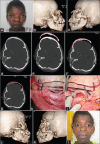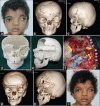Rigid versus Resorbable Plate Fixation in Fronto-Orbital Advancement in Unicoronal Stenosis - A Retrospective Study
- PMID: 36199468
- PMCID: PMC9527842
- DOI: 10.4103/ams.ams_35_22
Rigid versus Resorbable Plate Fixation in Fronto-Orbital Advancement in Unicoronal Stenosis - A Retrospective Study
Abstract
Introduction: Rigid plating fixation (RPF) and resorbable plating systems (RPS) advanced the field of reconstruction in craniomaxillofacial region. However, their performance in patients, particularly the effect on bone remodeling at site of hardware placement is not much documented. This manuscript aims to compare the performance of RPF and RPS in a cohort using a retrospective audit of case records.
Methods: Archival records were searched for patients who had undergone cranial metal-RPF or RPS or combination for the correction of craniofacial deformities following inclusion-exclusion criteria. From records, data of the quality and quantity of bone formed along the site of plate fixation as compared with the adjacent site, accommodating or facilitating brain growth, and persistence of bone deformity at the site of hardware placement were collected at the end of the follow-up period. A total of 128 sites from 18 individuals (6 with exclusive metal-RPF and 12 with RPS) mean age of 7.45 ± 7.28 (Median 4; IQR of 8.88;2.6-11.5) who underwent cranial bone remodeling surgery formed the study group.
Results: There was a statistically significant difference between the RPF and PRS system at the fronto-orbital suture (P = 0.002) and coronal suture (P = 0.036) with bone quality and quantity.
Discussion: The RPF system was rigid but had a set of issues, while RPS has advantages and limitations. The qualitative difference in between the two systems is different. Due to inherent dissimilarity, the two systems cannot be interchanged and due diligence has to be exercised while deciding on the system. More prospective studies are needed to validate the findings.
Keywords: Fronto-zygomatic sutures; resorbable plates; rigid plating fixation; sonic welding; supraorbital osteotomy.
Copyright: © 2022 Annals of Maxillofacial Surgery.
Conflict of interest statement
Dr. SM Balaji is associated as the Editor-in-Chief of this journal and this manuscript was subject to this journal’s standard review procedures, with this peer review handled independently of the Editor-in-Chief and their research group.
Figures


Similar articles
-
Stability of fronto-orbital advancement in nonsyndromic bilateral coronal synostosis: a quantitative three-dimensional computed tomographic study.Plast Reconstr Surg. 1996 Sep;98(3):393-405; discussion 406-9. doi: 10.1097/00006534-199609000-00002. Plast Reconstr Surg. 1996. PMID: 8700973
-
Rigid Plate Fixation for Closure of Emergent Sternotomies for Trauma.Am Surg. 2024 Apr;90(4):648-654. doi: 10.1177/00031348231206577. Epub 2023 Oct 16. Am Surg. 2024. PMID: 37842929
-
Unicoronal Craniosynostosis and Plagiocephaly Correction with Fronto-orbital Bone Remodeling and Advancement.Ann Maxillofac Surg. 2017 Jan-Jun;7(1):108-111. doi: 10.4103/ams.ams_80_17. Ann Maxillofac Surg. 2017. PMID: 28713746 Free PMC article.
-
A comparison of combinations of titanium and resorbable plating systems for repair of isolated zygomatic fractures in the adult: a quantitative biomechanical study.Ann Plast Surg. 2005 Apr;54(4):402-8. doi: 10.1097/01.sap.0000151484.59846.62. Ann Plast Surg. 2005. PMID: 15785282 Review.
-
Pediatric zygomatico-orbital complex fractures: the use of resorbable plating systems. A case report.J Craniomaxillofac Trauma. 1998 Winter;4(4):32-6. J Craniomaxillofac Trauma. 1998. PMID: 11951279 Review.
References
-
- Lee JS, Yu JW. In:The History of Maxillofacial Surgery. Cham: Springer; 2022. Craniosynostosis surgery; pp. 367–90.
-
- Mulliken JB, Kaban LB, Evans CA, Strand RD, Murray JE. Facial skeletal changes following hypertelorbitism correction. Plast Reconstr Surg. 1986;77:7–16. - PubMed
-
- Deveci M, Eski M, Gurses S, Yucesoy CA, Selmanpakoglu N, Akkas N. Biomechanical analysis of the rigid fixation of zygoma fractures:An experimental study. J Craniofac Surg. 2004;15:595–602. - PubMed
-
- Fearon JA. Rigid fixation of the calvaria in craniosynostosis without using “rigid”fixation. Plast Reconstr Surg. 2003;111:27–38. - PubMed
LinkOut - more resources
Full Text Sources
